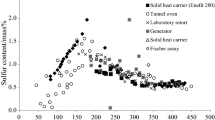Abstract
Oil shale is abundant in the world. Today, the industry of oil shale retorting for producing shale oil is developing owing to high price of oil in the world. In order to study migratory behavior of trace elements in oil shale at microwave pyrolysis, tests were performed in laboratory with oil shale of the Huadian deposit of China at different powers from 400 to 700 W. The trace elements As, Cd, Hg, Mo, Pb, Se, Cr, Cu, Ni, V, Zn, Ba, Co, Mn present in oil shale and shale char were determined by the inductively coupled plasma-mass spectrometry (ICP-MS). By comparing the content of trace elements in oil shale and shale char, distribution characteristics of trace elements at retorting were studied. The overall trends of volatile ratio of trace elements are ascending with higher microwave power and higher than the conventional pyrolysis. The differences in the volatile ratio indicate that the trace elements investigated are bound with the oil shale kerogen and its mineral matter in different manner. So Float-sink experiments (FSE) were performed on oil shale. Huadian oil shale has more included mineral. The volatilization of organic matter is not the main reason for the volatilization of trace elements in oil shale. The trace elements combined with the mineral elements may be also certain volatility.
Access this chapter
Tax calculation will be finalised at checkout
Purchases are for personal use only
Similar content being viewed by others
References
Qing W, Baizhong S, Xiahua W, Jingru B, Jian S. Study on combustion characteristics of mixtures of Huadian oil shale and semicoke. Oil Shale. 2007;24(2):135–45.
Appleton TJ, Colder RI, Kingman SW, Lowndes IS, Read AG. Microwave technology for energy-efficient processing of waste. Appl Energ. 2005;81(1):85–113.
Meredith RJ. Engineers’ handbook of industrial microwave heating. London: Institution of Electrical Engineers; 1998.
Ben Chanaa M, Lallemant M, Mokhlisse A. Pyrolysis of Timahdit, Morocco, oil shales under microwave field. Fuel. 1994;73(10):1643–9.
Bradhurst DH, Worner HK. Evaluation of oil produced from the microwave retorting of Australian shales. Fuel. 1996;75(3):285–8.
El Harfi K, Mokhlisse A, Chanaa MB, Outzourhit A. Pyrolysis of the Moroccan (Tarfaya) oil shales under microwave irradiation. Fuel. 2000;79(7):733–42.
Dominguez A, Menendez JA, Fernandez Y, Pis JJ, Nabais JMV, Carrott PJM, Ribeiro Carrott MML. Conventional and microwave induced pyrolysis of coffee hulls for the production of a hydrogen rich fuel gas. J Anal Appl Pyrol. 2007;79(1–2):128–35.
Sun BZ, Wang Q, Li SH, Wang HG. Analysis of specific area and porous structure of oil shale and semi-coke. J Power Eng. 2008;28(1):163–7.
Wang Q, Bai JR, Sun BZ. Strategy of Huadian oil shale comprehensive utilization. Oil Shale. 2005;22(3):305–16.
Liu ZJ, Liu R. Oil shale resource state and evaluating system. Earth Sci Frontiers. 2005;12(3):315–23.
Pan ZM. Temperature measurement in the application of microwave heating. J Shenzhen Univ (Sci Eng). 2002;19(2):81–4.
Shi QX, He W, Han LQ. Contacting temperature measuring instrumentspecial for microwave oven [P]. CN, 1724943A. 25, Jan, 2006.
Bai JR, Wang Q, Li CY, et al. Research to trace element during Huadian Oil Shale Pyrolysis[J]. Challenges Power Eng Environ. 2007;185–90.
Acknowledgments
The authors are grateful for the financial support the National Natural Science Foundation of China (Project No. 50876018) and the Doctorscientific Research Fund of Northeast Dianli University (Project No. BSJXM-201007).
Author information
Authors and Affiliations
Corresponding author
Editor information
Editors and Affiliations
Rights and permissions
Copyright information
© 2013 Springer-Verlag Berlin Heidelberg & Tsinghua University Press
About this paper
Cite this paper
Bai, Jr., Wang, Q., Kong, Lw., Bai, Z. (2013). Volatile Characteristic of Trace Elements During Microwave Pyrolysis of Oil Shale. In: Qi, H., Zhao, B. (eds) Cleaner Combustion and Sustainable World. ISCC 2011. Springer, Berlin, Heidelberg. https://doi.org/10.1007/978-3-642-30445-3_33
Download citation
DOI: https://doi.org/10.1007/978-3-642-30445-3_33
Published:
Publisher Name: Springer, Berlin, Heidelberg
Print ISBN: 978-3-642-30444-6
Online ISBN: 978-3-642-30445-3
eBook Packages: EnergyEnergy (R0)




